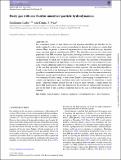Files in this item
Dusty gas with one fluid in smoothed particle hydrodynamics
Item metadata
| dc.contributor.author | Laibe, G. | |
| dc.contributor.author | Price, D.J. | |
| dc.date.accessioned | 2014-09-08T16:01:01Z | |
| dc.date.available | 2014-09-08T16:01:01Z | |
| dc.date.issued | 2014-05-21 | |
| dc.identifier | 146777318 | |
| dc.identifier | 469cc765-c88d-4d24-9070-00a275d290a2 | |
| dc.identifier | 84898822646 | |
| dc.identifier | 000334744000019 | |
| dc.identifier.citation | Laibe , G & Price , D J 2014 , ' Dusty gas with one fluid in smoothed particle hydrodynamics ' , Monthly Notices of the Royal Astronomical Society , vol. 440 , no. 3 , pp. 2147-2163 . https://doi.org/10.1093/mnras/stu359 | en |
| dc.identifier.issn | 0035-8711 | |
| dc.identifier.uri | https://hdl.handle.net/10023/5376 | |
| dc.description | This work was funded via Australian Research Council (ARC) Discovery Project grant DP1094585. GL acknowledges funding from the European Research Council for the FP7 ERC advanced grant project ECOGAL. DJP is very grateful for funding via an ARC Future Fellowship (FT130100034). | en |
| dc.description.abstract | In a companion paper we have shown how the equations describing gas and dust as two fluids coupled by a drag term can be re-formulated to describe the system as a single-fluid mixture. Here, we present a numerical implementation of the one-fluid dusty gas algorithm using smoothed particle hydrodynamics (SPH). The algorithm preserves the conservation properties of the SPH formalism. In particular, the total gas and dust mass, momentum, angular momentum and energy are all exactly conserved. Shock viscosity and conductivity terms are generalized to handle the two-phase mixture accordingly. The algorithm is benchmarked against a comprehensive suit of problems: dustybox, dustywave, dustyshock and dustyoscill, each of them addressing different properties of the method. We compare the performance of the one-fluid algorithm to the standard two-fluid approach. The one-fluid algorithm is found to solve both of the fundamental limitations of the two-fluid algorithm: it is no longer possible to concentrate dust below the resolution of the gas (they have the same resolution by definition), and the spatial resolution criterion h < c(s)t(s), required in two-fluid codes to avoid over-damping of kinetic energy, is unnecessary. Implicit time-stepping is straightforward. As a result, the algorithm is up to ten billion times more efficient for 3D simulations of small grains. Additional benefits include the use of half as many particles, a single kernel and fewer SPH interpolations. The only limitation is that it does not capture multi-streaming of dust in the limit of zero coupling, suggesting that in this case a hybrid approach may be required. | |
| dc.format.extent | 17 | |
| dc.format.extent | 2378669 | |
| dc.language.iso | eng | |
| dc.relation.ispartof | Monthly Notices of the Royal Astronomical Society | en |
| dc.subject | Hydrodynamics | en |
| dc.subject | Methods: numerical | en |
| dc.subject | Protoplanetary discs | en |
| dc.subject | Dust, extinction | en |
| dc.subject | QB Astronomy | en |
| dc.subject | QC Physics | en |
| dc.subject.lcc | QB | en |
| dc.subject.lcc | QC | en |
| dc.title | Dusty gas with one fluid in smoothed particle hydrodynamics | en |
| dc.type | Journal article | en |
| dc.contributor.sponsor | European Research Council | en |
| dc.contributor.institution | University of St Andrews. School of Physics and Astronomy | en |
| dc.identifier.doi | https://doi.org/10.1093/mnras/stu359 | |
| dc.description.status | Peer reviewed | en |
| dc.identifier.grantnumber | en |
This item appears in the following Collection(s)
Items in the St Andrews Research Repository are protected by copyright, with all rights reserved, unless otherwise indicated.

